pellets or passed them in their
excrement; | excrement; 1859 1860 1861 1866 1872 | | excre- ment; 1869 |
| their 1859 1860 1861 1866 | | the 1869 1872 |
| 8 blocks not present in 1859 1860 1861 1866; present in 1869 1872 | | Locusts are sometimes blown to great distances from the land; I myself caught one 370 miles from the coast of Africa, and have heard of others caught at greater distances.
The Rev. R. T. Lowe informs
Sir C. Lyell that in November 1844 swarms of locusts visited the island of Madeira.
They were in countless numbers, as thick as the flakes of snow in the heaviest snowstorm, and extended upwards as far as could be seen with a telescope.
During two or three days they slowly careered round in the air
in an immense ellipse, at least five or six miles in diameter, and at night alighted on the taller trees
which were completely coated with them.
They then disappeared over the sea, as suddenly as they had appeared, and have not since visited the island.
Now, in parts of Natal it is believed by some of the
farmers, though on quite
insufficient evidence, that injurious seeds are introduced into their grass-land in the dung left by the great flights of locusts which often visit that country.
In consequence of this belief Mr. Weale sent me in a letter a small packet of the dried pellets, out of which I extracted under the microscope several seeds, and raised from them seven grass plants, belonging to two species, in
two genera.
Hence a swarm of locusts, such as that which visited Madeira, might readily be the means of introducing several kinds of plants into an island lying far from the mainland.
|
|
|
Although the beaks and feet of birds are generally
quite | quite 1859 1860 1861 1866 | quite 1869 1872 |
| OMIT 1861 1866 1869 1872 |
| I can show that 1859 1860 |
| case 1861 1866 1869 1872 | | instance 1859 1860 |
| sixty-one 1861 1866 1869 1872 | | twenty-two 1859 1860 |
| grains, 1861 1866 1869 1872 | | grains 1859 1860 |
| and in another case twenty-two grains of 1861 1866 1869 1872 |
| of 1859 1860 |
| one 1859 1860 1861 1866 1869 | | the 1872 |
| the 1861 1866 1869 1872 | | this 1859 1860 |
| quite 1859 1860 1861 1866 | quite 1869 1872 |
| 1 blocks not present in 1859 1860 1861 1866; present in 1869 1872 | | Here is a better case: the leg of a woodcock was sent to me by a friend, with a little cake of dry earth attached to the shank, weighing only nine grains; and this contained a seed of the toad-rush (Juncus bufonius) which germinated and flowered.
|
| every-where 1866 | | everywhere 1859 1860 1861 |
| I will give one case:— Mr. 1866 |
| For instance, Prof. 1869 1872 |
| round the wounded leg and foot 1866 |
| with 1869 1872 |
| had collected, and this when removed weighed 1866 |
| adhering to it, and weighing 1869 1872 |
| included, 1866 | | consisted, 1869 1872 |
| feet? 1866 |
| feet or beaks? 1869 1872 |
| presently 1859 1860 1861 1866 | presently 1869 1872 |
|
|
As icebergs are known to be sometimes loaded with earth and stones, and have even carried brushwood, bones, and the nest of a land-bird,
it | it 1861 1866 1869 1872 | | I 1859 1860 |
| be doubted 1861 1866 1869 1872 | | doubt 1859 1860 |
| occasionally, 1866 1869 1872 | | occasionally 1859 1860 1861 |
| as suggested by Lyell, have 1866 1869 1872 |
| have 1859 1860 1861 |
|









